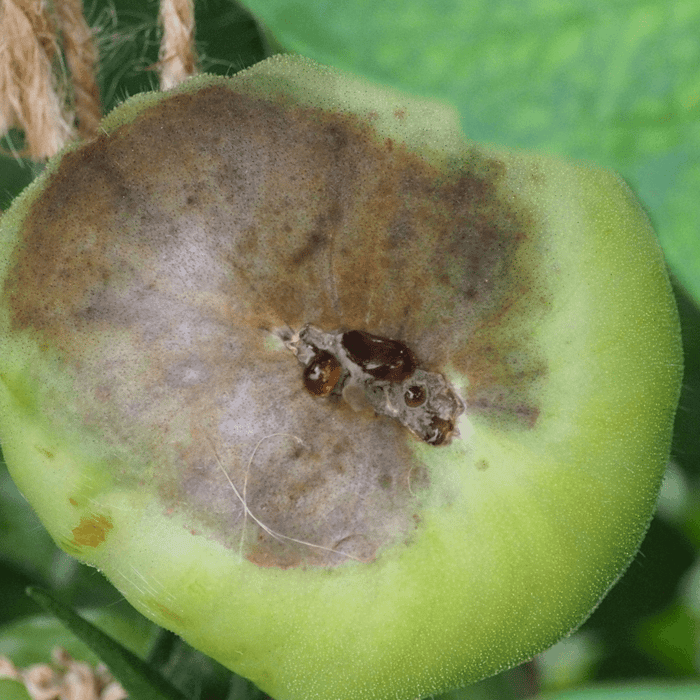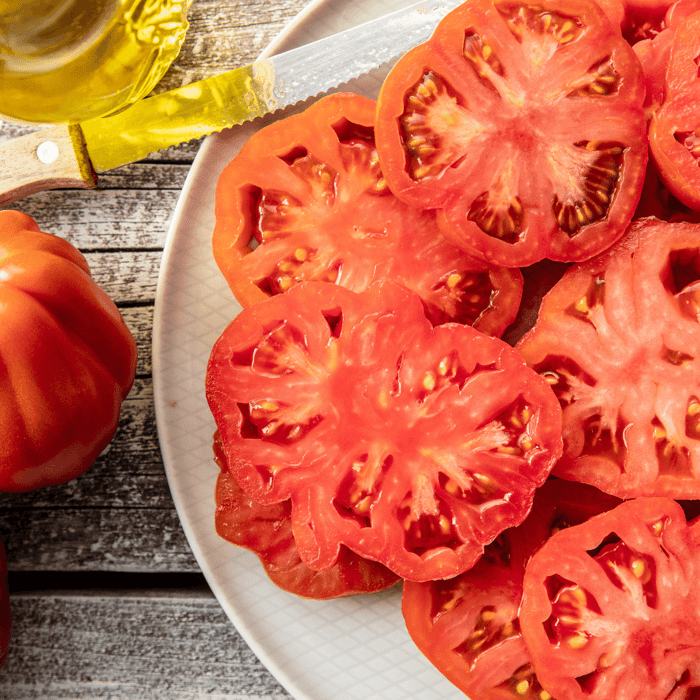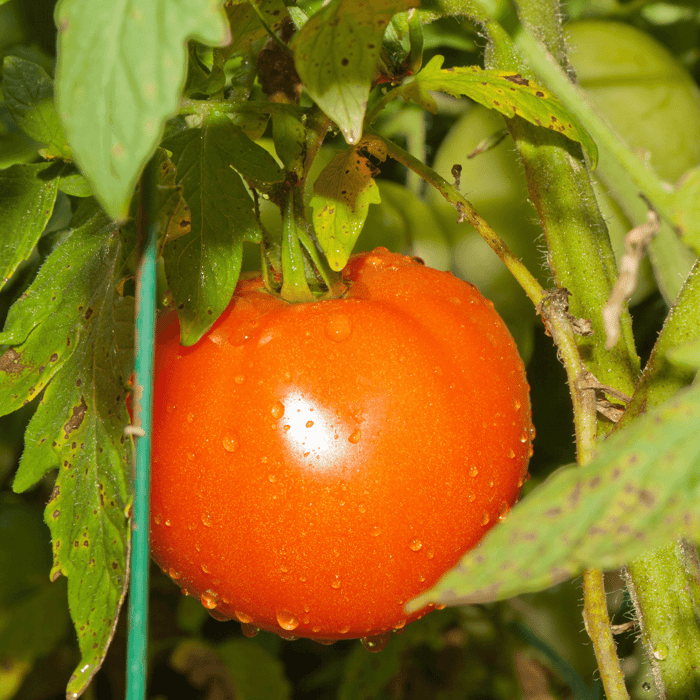As a gardener, you might be familiar with the pesky problem called "blossom end rot." It's a condition that affects tomatoes, causing them to develop dark, sunken spots on their bottoms. These spots can spread and turn the whole tomato into an inedible mush. Let's dive into the age-old question of can you eat tomatoes with blossom end rot?
But what exactly is blossom end rot? Blossom end rot is a common physiological disorder in tomatoes caused by calcium deficiency.
When calcium levels are low or unevenly distributed throughout the plant, it damages cell wall and forms those dark spots on the fruit's bottom. This condition often appears when plants are stressed due to drought, over-fertilization, or inconsistent watering.
Now comes the million-dollar question: Can you still eat tomatoes with blossom end rot? The answer is yes and no.
While it's generally not advisable to eat tomatoes with significant signs of blossom end rot, some parts of the fruit may still be safe for consumption. When picking tomatoes from your garden, examine each one closely for signs of blossom end rot.
If you spot just a small spot on one side and feel that most of the tomato looks healthy and ripe, you could still salvage it by cutting off that blackened area with a paring knife. However, if more than half of your tomato shows signs of severe blossom end rot or is soft and mushy on parts other than just at its bottom, it would be best not to eat it.
It’s better to cut these undesired fruits off your plant so they don’t invite pests or diseases into your garden soil. So there’s always some risk associated with eating any fruit affected by an agricultural problem like this one – including whether they were grown conventionally or organically –,. However, if you’re willing to cut around the affected areas, you might still be able to eat your homegrown tomatoes.
What is Blossom End Rot?
Defining Blossom End Rot
Blossom end rot (BER) is a physiological disorder that affects tomatoes and other plant species. It appears as a dark, sunken spot at the bottom of the fruit, near the blossom end. The affected area can range in size from small dots to large patches depending on the severity of the condition.
Blossom End Rot Causes
Blossom end rot is caused by a calcium deficiency in developing fruits. Calcium is an essential nutrient that helps maintain cell structure and helps regulate growth hormones in tomatoes. The calcium deficiency can be due to several factors, including acidic soil conditions, inadequate watering, especially during dry spells, high levels of nitrogen fertilizers usage, or root damage that makes it difficult for plants to absorb necessary nutrients.
Other factors include excessive heat at flowering time or rapid fluctuations between wet and dry soil conditions. Typically this occurs early on when plants are actively growing fruits but haven't yet established proper water uptake mechanisms.
Blossom End Rot Effects
When blossom end rot first appears on tomato plants, you may notice small water-soaked spots that gradually increase in size over time. As time goes on, these spots become darker black and sunken.
As this develops further, it will cause increased fruit drop,, resulting in lower yield output for growers that rely heavily upon their crops,, such as farmers or market gardeners. Due to its effect on the texture of affected fruits, BER damage makes them unsuitable for sale as fresh produce, but they can still be used for cooking purposes - we'll get into more detail later in the article.
Tomato Seed Assortment | 8 Variety Pack
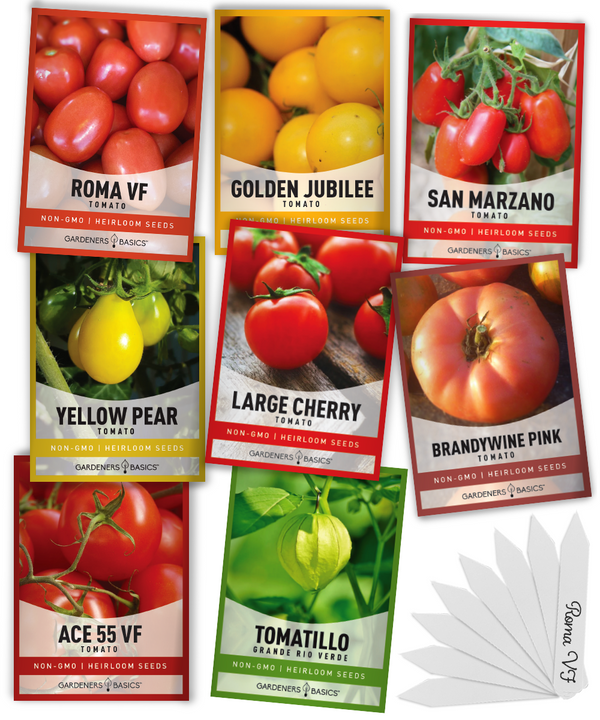
$15.95
8 Tomato Seeds Variety Pack – Heirloom, Non-Hybrid, Open-Pollinated, Non-GMO – Perfect for Home Gardens! Unlock the secrets to a thriving tomato garden with our premium 8 Tomato Seeds Variety Pack! Carefully curated for tomato lovers and gardening enthusiasts alike, this… read more
Can You Eat Tomatoes with Blossom End Rot?
Is it Safe to Eat Tomatoes with Blossom End Rot?
Blossom end rot is a common problem among tomato growers, and it can be disheartening to see your beautiful tomatoes ruined by this condition. However, the good news is that while the affected part of the tomato should be removed, the rest of the fruit is safe to eat. This is because blossom end rot only affects a small portion of the tomato, specifically the bottom portion where it attaches to the vine.
If you have a tomato with blossom end rot, you'll know it because there will be a brown, sunken spot on the bottom of the fruit. While this may look unappetizing, rest assured that after removing this part of the tomato, you'll still have plenty of delicious fruit left over.
How to Remove Blossom End Rot from Tomatoes
To remove blossom end rot from tomatoes, cut off the affected portion using a sharp knife or scissors. Be sure to cut generously around and below any brown spots to get rid of all affected tissue. Once you have removed this section of your tomato, you'll be left with clean and healthy fruit.
It's important to note that once tomatoes have developed blossom end rot, they will likely develop more spots in subsequent fruits. Therefore, by removing these affected portions as soon as possible and taking steps to prevent future occurrences (which we'll cover later on), you can help ensure that your plants continue producing delicious fruits throughout their growing season.
The Importance of Proper Storage
When storing tomatoes with blossom end rot removed, it's important to keep them in a cool area away from direct sunlight. This will help prevent any remaining bacteria or fungus from spreading to other parts of the tomato.
Additionally, you may want to store these tomatoes in a separate area from your healthy ones, just to be safe. If you notice further signs of decay or spoilage in your tomatoes, discard them immediately.
Using Blossom End Rot Tomatoes in Recipes
Now that you know it's safe to eat tomatoes with blossom end rot (as long as the affected part is removed), you may wonder what to do with them. Luckily, there are plenty of ways to use these slightly damaged fruits in your cooking!
For example, chopped-up blossom end rot tomatoes can be used in salsa or bruschetta recipes without any problems. You can also use them in stews and soups where their slightly softer texture won't be noticeable.
In fact, because blossom end rot does not affect the overall taste of the tomato, it's still perfectly fine for use in any recipe that calls for fresh tomatoes. So don't let a little bit of brown spoilage stop you from enjoying all the delicious flavors fresh tomatoes offer!
How to Identify Blossom End Rot on Tomatoes
The Culprit: Calcium Deficiency
Blossom end rot is a common condition in tomato plants that arises from a lack of calcium in the fruit. The first signs of this deficiency are seen on the bottommost part of the tomato, known as the blossom end. It usually starts as a small, water-soaked lesion that appears grayish-brown.
Appearance and Progression
As blossom end rot develops, it becomes larger and darker, eventually turning black and becoming firmer. It can cover one-third to half of the fruit's surface area in advanced stages. Blossom end rot can also spread to other plant areas, including leaves, stems, and flowers.
Inspection Techniques for Blossom End Rot
To identify blossom end rot on tomato plants, inspect your fruits carefully using your naked eye or a magnifying glass if needed. You may notice a dark spot at its base, that eventually grows larger and becomes sunken with an inverse cone shape, indicating an internal browning when we cut it out.
You should monitor tomatoes regularly to detect any signs of the disease early enough so that you can address it before it spreads throughout your garden. To avoid mistakes while identifying blossom end rot - note that other factors could cause similar symptoms, such as insect damage or early blight - check for wilting leaves or leaf spots that often accompany early
blight.
Prevention Tips for Blossom End Rot
It's easier to prevent blossom end rot than cure it once it has set in, as there is no cure once affected by this condition. To reduce risk factors causing low calcium absorption by tomatoes' roots, add calcium-rich fertilizers into the soil weeks before planting tomatoes. Consistently maintain optimal moisture levels, too, because too dry or too wet soil could affect the uptake of calcium by the tomato roots. By following these tips, you can prevent blossom end rot and grow healthy, delicious tomatoes all season.
Heirloom Tomato Seeds for Planting | 16 Variety Pack
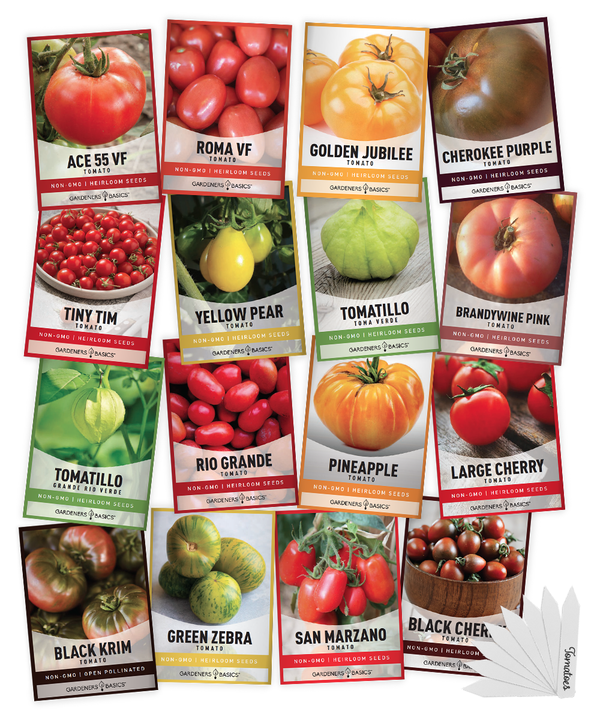
$19.95
The Ultimate Tomato Seed Variety Set - 16 Heirloom, Non-GMO Tomato Varieties for Your Home Garden Introducing our 16 Tomato Seeds Variety Pack, a must-have collection for any gardening enthusiast or professional grower! This premium seed assortment includes a diverse selection… read more
How to Prevent Blossom End Rot on Tomatoes
The Importance of Preventing Blossom End Rot
Before we dive into how to prevent blossom end rot, it's important to understand why you must take steps to prevent it. As discussed in previous sections, blossom end rot can cause significant damage to your tomato plants and make them unsuitable for consumption.
Not only that, but it can also spread quickly and affect other plants in your garden. Taking preventative measures early on can ensure healthy tomato plants with plenty of delicious fruits.
Proper Soil Moisture Levels
One of the primary causes of blossom end rot is irregular watering practices that result in fluctuating soil moisture levels. To prevent this, ensure you provide your
tomato plants with consistent moisture by watering them deeply and regularly.
Aiming for 1-2 inches of water per week is a good rule of thumb. One way to assess whether or not your soil has sufficient moisture is by sticking a finger about an inch into the soil; if it feels dry at that depth, then it's time to water.
Balance Nutrient Levels
Like most plants, tomatoes require a balance of nutrients to thrive. An imbalance or deficiency in certain nutrients can cause issues such as blossom end rot and other diseases. When planting tomatoes (or any plant), consider using a balanced fertilizer or compost mix that contains all the essential macro- and micronutrients required for healthy plant growth.
Avoid Over-Fertilizing
While providing ample nutrients is critical for preventing blossom end rot on tomatoes, over-fertilizing can be as damaging as under-fertilizing. Too much nitrogen, for example, can lead to excess foliage growth at the expense of fruit production.
Additionally, over-fertilizing can cause soil salinity levels to rise, further compounding the problem of blossom end rot. Follow recommended fertilizer application rates and avoid adding more than necessary.
By following these tips and taking steps early on to prevent blossom end rot, you can ensure that your tomato plants will produce healthy, delicious fruits all season. Remember to keep soil moisture levels consistent, balance nutrient levels properly, and avoid over-fertilizing to keep your plants in top shape.
Conclusion
The Good, The Bad, and the Tomatoes
So, can you eat tomatoes with blossom end rot? The answer is both yes and no.
While eating the unaffected parts of a tomato with blossom end rot is safe, it's also important to note that this condition is a sign of nutrient deficiency and improper soil moisture levels. By eating these tomatoes, you're missing out on a healthy tomato plant's full flavor and nutrition.
Preventing Blossom End Rot
The good news is that preventing blossom end rot in your garden is easy. By maintaining proper moisture levels in your soil through regular watering and ensuring your plants have ample access to calcium-rich fertilizers or compost, you can stop blossom end rot before it starts. Additionally, checking your garden for signs of stress or nutrient deficiency can help catch issues early on.
A Final Word
Tomatoes are a delicious staple in any kitchen. While they may be susceptible to conditions like blossom end rot, rest assured that by taking preventative measures early on, you'll enjoy healthy and tasty tomatoes all season long. Whether you're an experienced gardener or just starting out gardening fresh produce at home, there's never been a better time to take control of your food source and grow your own delicious tomatoes today!
 Frequently Asked Questions - Can You Eat Tomatoes With Blossom End Rot?
Frequently Asked Questions - Can You Eat Tomatoes With Blossom End Rot?
Yes, you can still eat tomatoes with blossom end rot, but it is recommended that you cut off the affected area before consuming them. Blossom end rot is a common condition that affects tomatoes, and it is caused by a lack of calcium in the fruit.
What Does Blossom End Rot Look Like?
Blossom end rot appears as a dark, sunken area at the bottom of the tomato, which can expand as the fruit matures. The affected area is usually discolored and may have a slightly mushy texture.
Can You Prevent Blossom End Rot?
Yes, you can prevent blossom end rot by ensuring your tomato plants receive adequate calcium and consistent watering. Adding lime or eggshells to the soil can also help increase the calcium content. Additionally, avoid over-fertilizing your plants with nitrogen, which can interfere with calcium absorption.
Can You Treat Blossom End Rot?
There is no cure for blossom end rot once it has developed. Still, you can help prevent further occurrences by addressing the underlying causes, such as calcium deficiency and inconsistent watering.
Are There Any Risks to Eating Tomatoes With Blossom End Rot?
No health risks are associated with consuming tomatoes with blossom end rot, but the affected area may have an unpleasant texture or taste. Cutting off the affected area before eating the tomato can help ensure a better flavor and texture.


 Frequently Asked Questions - Can You Eat Tomatoes With Blossom End Rot?
Frequently Asked Questions - Can You Eat Tomatoes With Blossom End Rot?


